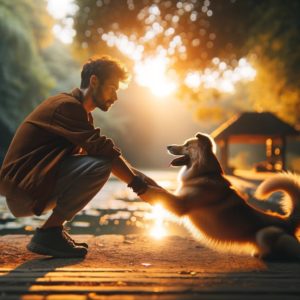Anthropomorphism is a term that refers to the tendency of humans to attribute human characteristics, emotions, or behaviors to non-human entities, such as animals or inanimate objects. While anthropomorphism can sometimes be benign or even foster a sense of connection with our pets, there are times when it can lead to misinterpretations of our pets’ behaviors and emotional signals. These misinterpretations can have serious consequences, ranging from distressed pets to a strained pet-human relationship.
Chapter 1: Understanding Anthropomorphism: Interpreting Animal Behavior Through a Human Lens
Anthropomorphism is a phenomenon that has intrigued psychologists, animal behaviorists, and pet owners alike. It is a term that refers to our tendency to attribute human characteristics, emotions, or behaviors to non-human entities, including our beloved pets. While this may seem like a harmless or even endearing quirk of human cognition, it can sometimes lead to misunderstandings and miscommunications. To foster healthier relationships with our pets, it’s important to delve deeper into the concept of anthropomorphism and understand its implications.
The Cognitive Basis of Anthropomorphism
At its core, anthropomorphism is a cognitive bias, an inherent flaw in our thought processes. This bias stems from our instinctive need to understand and interpret the world around us. Humans are inherently social creatures. We have evolved to recognize and understand human emotions and behaviors, and we are more comfortable dealing with entities that we can relate to on a human level.
When we interact with animals, we instinctively apply our understanding of human behavior to make sense of their actions. Therefore, we tend to impose our human mental models onto our pets. This is not done consciously or with any intent to misinterpret; it’s simply the way our brains are wired.
Anthropomorphism in Action: An Example
Let’s consider an example. When our dog jumps around in excitement as we walk in the door, we might interpret this as joy because, as humans, we express our happiness in a somewhat similar fashion. The dog’s behavior seems to mirror our own expressions of joy, so we assume it must mean the same thing.
However, while this interpretation might sometimes be accurate, it’s not always the case. Dogs, like all animals, have their own unique ways of expressing emotions that may not always align with human expressions. The dog might also be expressing relief, anticipation, or even anxiety. Misinterpreting these emotions can lead to inappropriate responses, which can, in turn, lead to confusion or distress in our pets.
The Dark Side of Anthropomorphism
In scenarios where our pets’ behaviors do not align with human behaviors, anthropomorphism can lead to gross misunderstandings. For instance, a cat might swish its tail when it’s agitated or threatened, while a dog might wag its tail when it’s happy. If a cat owner, accustomed to dogs, misinterprets this signal, it could lead to an unpleasant encounter.
Moreover, anthropomorphism can result in us attributing complex human emotions and thoughts to our pets, which they may not be capable of. Pets do have emotions, but their emotional range and depth are believed to be more limited compared to humans. Assigning human-like motives to our pets’ behaviors can not only lead to misunderstandings but can also place undue stress on our pets by expecting them to behave in ways they are not naturally inclined to.
__
Anthropomorphism is a fascinating aspect of human cognition, but it’s one that pet owners need to be aware of. By understanding what anthropomorphism is and how it influences our interpretation of our pets’ behaviors, we can better empathize with our pets and respond to their needs in a more informed and understanding way. After all, effective communication is key to any relationship, including the ones we share with our four-legged friends.







